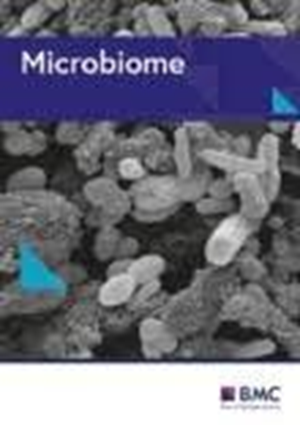基于性状的研究预测甘油/二醇脱水酶是后肠发酵食肉动物肠道微生物群的一项关键功能
IF 13.8
1区 生物学
Q1 MICROBIOLOGY
引用次数: 0
摘要
微生物 pdu 和 cob-cbi-hem 基因簇编码关键的甘油/二醇脱水酶(PduCDE)和钴胺素合成酶,前者介导膳食营养物质甘油和 1,2-丙二醇(1,2-PD)向多种代谢物的转化,后者则是一种辅助因子,也是微生物群落的共同利器。本研究的目的是将 pdu 这一多功能性状与环境条件和微生物群落组成联系起来。我们收集了不同肠道生理机能和饮食习惯的人工饲养野生动物的粪便样本(n = 55,共 104 个样本),采用元基因组学与代谢和遗传生物标记物定量相结合的新方法确定了 pdu 和 cob-cbi-hm 的发生率和多样性,并进行了体外发酵以测试基于性状的活性。粪便中甘油转化产物 1,3-丙二醇(1,3-PD)的含量在后肠发酵者中高于前肠发酵者。基于基因的分析表明,携带 pduC 的类群是圈养野生动物粪便微生物群的共同特征,在后肠发酵罐中出现的频率更高,丰度也更高。根据元基因组序列重建的基因组的系统发育分析表明,圈养野生动物粪便微生物群在分类学上非常丰富,共有 4150 个物种,超过 1800 个新物种,但只有 56 个物种至少部分携带 pdu 和 cbi-cob-hem。前肠发酵食草动物粪便样本中的分类多样性最高,而后肠发酵食肉动物体外微生物群中的pduC丰度较高,pdu/cbi-cob-hem多样性较高,这与它们利用甘油和1,2-PD的潜力较高有关。我们的方法结合了代谢物和基因生物标志物分析、元基因组学和表型鉴定,确定了 Pdu 是少数类群所共有的圈养野生动物粪便微生物群的共同功能,并根据宿主的饮食和生理状况对粪便微生物群利用甘油/1,2-PD 和合成钴胺素的潜力进行了分层。这项基于性状的研究表明,利用甘油/1,2-PD的能力是后肠发酵食肉动物的一项关键功能,它与总体群落多样性无关,但与钴胺素形成的潜力有关。本文章由计算机程序翻译,如有差异,请以英文原文为准。
Trait-based study predicts glycerol/diol dehydratases as a key function of the gut microbiota of hindgut-fermenting carnivores
Microbial pdu and cob-cbi-hem gene clusters encode the key enzyme glycerol/diol dehydratase (PduCDE), which mediates the transformation of dietary nutrients glycerol and 1,2-propanediol (1,2-PD) to a variety of metabolites, and enzymes for cobalamin synthesis, a co-factor and shared good of microbial communities. It was the aim of this study to relate pdu as a multipurpose functional trait to environmental conditions and microbial community composition. We collected fecal samples from wild animal species living in captivity with different gut physiology and diet (n = 55, in total 104 samples), determined occurrence and diversity of pdu and cob-cbi-hem using a novel approach combining metagenomics with quantification of metabolic and genetic biomarkers, and conducted in vitro fermentations to test for trait-based activity. Fecal levels of the glycerol transformation product 1,3-propanediol (1,3-PD) were higher in hindgut than foregut fermenters. Gene-based analyses indicated that pduC harboring taxa are common feature of captive wild animal fecal microbiota that occur more frequently and at higher abundance in hindgut fermenters. Phylogenetic analysis of genomes reconstructed from metagenomic sequences identified captive wild animal fecal microbiota as taxonomically rich with a total of 4150 species and > 1800 novel species but pointed at only 56 species that at least partially harbored pdu and cbi-cob-hem. While taxonomic diversity was highest in fecal samples of foregut-fermenting herbivores, higher pduC abundance and higher diversity of pdu/cbi-cob-hem related to higher potential for glycerol and 1,2-PD utilization of the less diverse microbiota of hindgut-fermenting carnivores in vitro. Our approach combining metabolite and gene biomarker analysis with metagenomics and phenotypic characterization identified Pdu as a common function of fecal microbiota of captive wild animals shared by few taxa and stratified the potential of fecal microbiota for glycerol/1,2-PD utilization and cobalamin synthesis depending on diet and physiology of the host. This trait-based study suggests that the ability to utilize glycerol/1,2-PD is a key function of hindgut-fermenting carnivores, which does not relate to overall community diversity but links to the potential for cobalamin formation.
求助全文
通过发布文献求助,成功后即可免费获取论文全文。
去求助
来源期刊

Microbiome
MICROBIOLOGY-
CiteScore
21.90
自引率
2.60%
发文量
198
审稿时长
4 weeks
期刊介绍:
Microbiome is a journal that focuses on studies of microbiomes in humans, animals, plants, and the environment. It covers both natural and manipulated microbiomes, such as those in agriculture. The journal is interested in research that uses meta-omics approaches or novel bioinformatics tools and emphasizes the community/host interaction and structure-function relationship within the microbiome. Studies that go beyond descriptive omics surveys and include experimental or theoretical approaches will be considered for publication. The journal also encourages research that establishes cause and effect relationships and supports proposed microbiome functions. However, studies of individual microbial isolates/species without exploring their impact on the host or the complex microbiome structures and functions will not be considered for publication. Microbiome is indexed in BIOSIS, Current Contents, DOAJ, Embase, MEDLINE, PubMed, PubMed Central, and Science Citations Index Expanded.
 求助内容:
求助内容: 应助结果提醒方式:
应助结果提醒方式:


